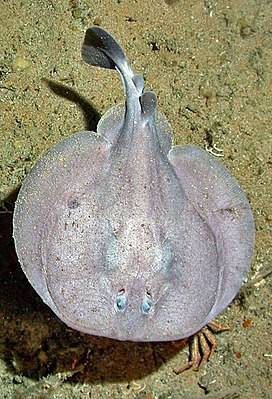Tetronarce
| Tetronarce | ||||||||||||
|---|---|---|---|---|---|---|---|---|---|---|---|---|

Atlantic electric ray ( Tetronarce nobiliana ) |
||||||||||||
| Systematics | ||||||||||||
|
||||||||||||
| Scientific name | ||||||||||||
| Tetronarce | ||||||||||||
| Gill , 1862 |
Tetronarce is a genus from the family of the torpedo (Torpedinidae).
features
Tetronarce species differ from the torpedo species, the second genus of electric rays, by their uniform, in most cases dark color without any pattern. In most cases they are blackish, gray, brownish or dark purple in color. Some species show inconspicuous dark spots. The ventral side is whitish, often with a dark border along the pectoral and pelvic fins. The body disc is approximately round, soft and flaccid. The top and bottom are scaly without denticles or thorns. The anterior part of the body disc is blunt, a rostral cartilage is missing or reduced. The tail is short, stocky and clearly separated from the body disc. A narrow fold of skin runs along both lower edges of the tail. The eyes are fully developed but small. The injection holes are small, sloping and, unlike those of the torpedo species, have smooth edges without papillae. The nostrils are relatively large, sloping and closer to the mouth than to the front edge of the body disc. The mouth is wide and arched. The upper jaw is occupied by 18 to 66 teeth, in the lower jaw one counted 19 to 61. The teeth are small, uniform and have flat bases and conspicuous tips, so they are not flat and plate-like, as is the case with many other rays. The gill slits are small, the first and fifth are slightly smaller than the third and fourth. The electrical organs are bean-shaped, their length is about half the length of the body disc. They are visible through the skin. The pelvic fins are rounded and not divided into an anterior and posterior lobe. The two close together, rounded to triangular dorsal fins are relatively large, the first is significantly larger than the second. The caudal fin is large, much larger than the dorsal fin, about the size of the pelvic fins or slightly larger. It is approximately triangular or paddle-shaped and consists only of an upper lobe, the lower one is missing. Tetronarce species have 95 to 97 vertebrae. The spiral bowel has 9 to 14 whorls. The largest species, the Atlantic electric ray, reaches a maximum length of 1.80 cm.
distribution
Most Tetronarce species live on the continental shelf , four species are deep-sea fish and occur on continental slopes or the corresponding habitats off islands.
Systematics
The genus Tetronarce was introduced in 1862 by the American ichthyologist Theodore Nicholas Gill , but was considered a subgenus of Torpedo for most of the time . In 2013, the Brazilian ichthyologist Marcelo de Carvalho raised Tetronarce to the rank of genus.
species
The genus Tetronarce currently has twelve species. However, the description of some species is very sparse.
- California electric ray ( Tetronarce californica ( Ayres , 1855) )
- Tetronarce cowleyi Ebert et al., 2015
- Tetronarce fairchildi (Hutton, 1872)
- Tetronarce formosa (Haas & Ebert, 2006)
- Tetronarce macneilli (Whitley, 1932)
- Tetronarce microdiscus (Parin & Kotlyar, 1985)
- Atlantic electric ray ( Tetronarce nobiliana ( Bonaparte , 1835) )
- Tetronarce peruana (Chirichigno F., 1963)
- Tetronarce puelcha (Lahille, 1926)
- Tetronarce semipelagica (Parin & Kotlyar, 1985)
- Tetronarce tokionis (Tanaka, 1908)
- Tetronarce tremens (de Buen, 1959)
Individual evidence
- ↑ a b c David A. Ebert: Deep-sea Cartilaginous Fishes of the Indian Ocean. Volume 1 Batoids and Chimaeras . FAO Species Catalog for Fishery Purposes No. 8, Vol. 2, ISSN 1020-8682, pages 30-31.
- ↑ Tetronarce on Fishbase.org (English)
- ^ Last, Carvalho, Corrigan, and others. Lei Yang: The Rays of the World project - an explanation of nomenclatural decisions PDF

